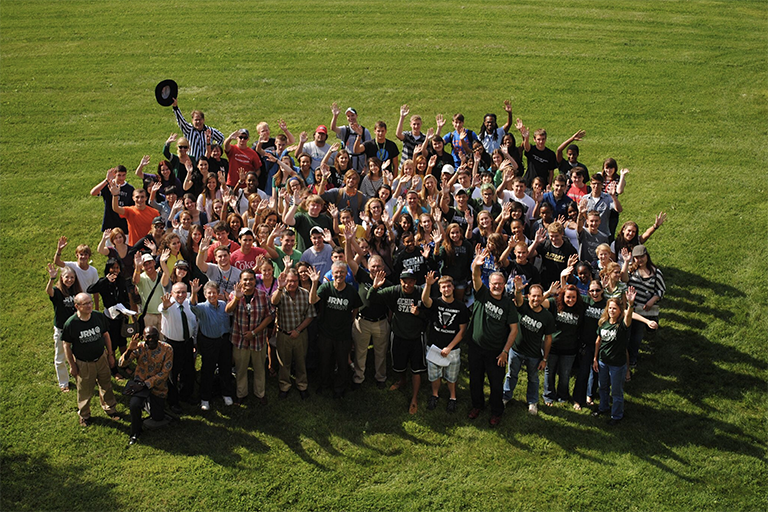History
Critical thinking, excellent writing and superb visual communication skills are the hallmarks of MSU’s School of Journalism graduates. It is considered one of the top journalism programs in the world.
The MSU Journalism program is one of the oldest and most vibrant programs in the country. The first journalism course was taught in 1910. It was one of the first programs to implement courses on news and information online and continues to be on the cutting edge with journalism and innovative technologies, while encompassing traditional writing and reporting principles.
In 1937, the first radio and newspaper management courses were developed. And, a year later, the first journalism internship program was established—the first of its kind in the nation. In 1942, the unit became known as the Department of Journalism and in 1955, the official title became the School of Journalism.
The School of Journalism was one of the first journalism programs to be nationally accredited (1949), and one of the very few to be continuously accredited every six years since then, by the Accrediting Council on Education in Journalism and Mass Communication (ACEJMC). In its most recent report, the accreditation team noted that MSU's School of Journalism "is in that select group of premier programs today" and that it is doing a "marvelous job of preparing students for the digital age."
The School of Journalism is housed in MSU’s College of Communication Arts and Sciences—the first college of communication in the country.
Mission
The School of Journalism at Michigan State University offers students the critical thinking, excellent writing and superb visual communication skills they need to be leaders in this exciting, evolving industry. Graduate students become great researchers and teachers at universities across the globe.
World-class faculty, known for cutting-edge scholarship (research and creative), and brilliant students share an entrepreneurial spirit of covering news and information in all forms and across multiple media platforms.
Faculty are consulted by global industry leaders, alumni hold prominent positions and students are award-winners. The school is growing and is ahead of the curve. Students entering MSU may begin taking journalism courses, and use the equipment and labs immediately in their first semester!
The MSU Journalism program's mission is to be known around the world for emphasizing strong journalism ethics in storytelling through writing and visual communication. It is also known for providing students with experiential hands-on learning and research, spanning traditional media to developing innovative technologies for educational and professional uses.
Most students have a job offer by the time they graduate. That means we have been successful at preparing students for their next step. Some students want to learn great writing and reporting skills, while other students want to apply those skills to particular topics. Still other students want to become researchers and founders of new knowledge that can be applied to help communities in our global village.
Another mission is to be on the cutting edge of the industry. Student portfolios may include innovative technology such as motion capture, drones, virtual reality, augmented content, 2D and 3D animation, game design, avatars in High Fidelity and Second Life, interactive apps for mobile devices, artificial intelligence and 360-degree video for interactive immersive environments.
The MSU School of Journalism offers the complete curriculum online every summer for students all over the world. That means, you can progress in your program while working or doing an internship anywhere in the world.
Vision
The School of Journalism boasts an eclectic ensemble of faculty drawn from a wide range of industry areas from traditional writing and broadcast news to innovative research, interactive media design, animation and immersive virtual worlds.
MSU Journalism students have daily collaborative contact with faculty whose professional portfolios for storytelling, design and interactive experiences include projects for National Geographic, Newsweek, ESPN, Associated Press, United Nations, U.S. Dept. of State, NY Times, NEA, NEH, US Dept. of Education, CNN, BBC, NPR, UNIVISION, Elle Magazine, the Today Show and the Smithsonian Institution along with numerous awards including Emmys, Pulitzers and Fulbrights.
They are productive faculty, who involve students in virtually all of their research, creative projects, publications and awards for experiential learning.
Students work with state-of-the-art computers and software in our new Spartan Newsroom, digital image projection and audio equipment in PC and Apple labs; fully equipped television production studios; editing suites and audio recording facilities. Students work on professional video and audio recording systems, cameras and associated accessories to produce award-winning journalism.
Students use the technology to produce national award-winning stories in print and digital publications, broadcast, interactive graphic design, video editing, 2D and 3D animation, immersive environments and sound production.
WKAR, Michigan’s top PBS TV, radio and digital station is also housed within the building and has one of the largest studios in the country. Students may intern with WKAR and student projects in several courses working with WKAR are aired on the station.
Across the hall on the first floor is the Spartan Newsroom, with glass walls, state-of-the-art technology and motion capture lab with 24 HD color cameras for full 360 degree motion and audio digital capture. The School of Journalism has the newest technology in the newest newsroom in the country!
